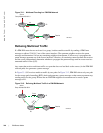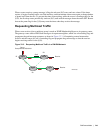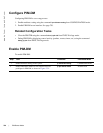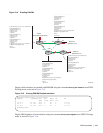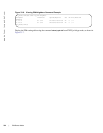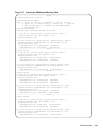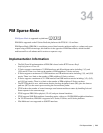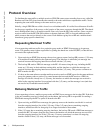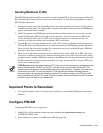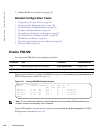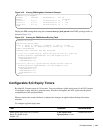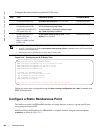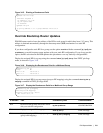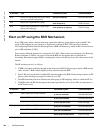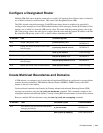756 | PIM Sparse-Mode
www.dell.com | support.dell.com
Protocol Overview
To distribute the same traffic to multiple receivers, PIM-SM creates a tree extending from a root, called the
Rendezvous Point (RP), down branches that extend to the nodes which have requested the traffic. Nodes
requesting the same traffic belong to the same multicast group.
Initially, a single PIM-SM tree called a shared tree to distribute traffic. It is called shared because all traffic
for the group, regardless of the source, or the location of the source, must pass through the RP. The shared
tree is unidirectional; that is, all multicast traffic flows only from the RP to the receivers. Once a receiver
receives traffic from the RP, PM-SM switches to shortest path trees (SPT) to forward multicast traffic,
which connects the receiver directly to the source. Each multicast group has an RP and a unidirectional
shared tree (group-specific shared tree).
Requesting Multicast Traffic
A host requesting multicast traffic for a particular group sends an IGMP Join message to its gateway
router. The gateway router is then responsible for joining the shared tree to the RP (RPT) so that the host
can receive the requested traffic.
1. Upon receiving an IGMP Join message, the receiver gateway router (last-hop DR) creates a (*,G) entry
in its multicast routing table for the requested group. The interface on which the join message was
received becomes the outgoing interface associated with the (*,G) entry.
2. The last-hop DR sends a PIM Join message to the RP. All routers along the way, including the RP,
create an (*,G) entry in their multicast routing table, and the interface on which the message was
received becomes the outgoing interface associated with the (*,G) entry. This process constructs an
RPT branch to the RP.
3. If a host on the same subnet as another multicast receiver sends an IGMP report for the same multicast
group, the gateway takes no action. If a router between the host and the RP receives a PIM Join
message for which it already has a (*,G) entry, the interface on which the message was received is
added to the outgoing interface list associated with the (*,G) entry, and the message is not (and does
not need to be) forwarded towards the RP.
Refusing Multicast Traffic
A host requesting to leave a multicast group sends an IGMP Leave message to the last-hop DR. If the host
is the only remaining receiver for that group on the subnet, the last-hop DR is responsible for sending a
PIM Prune message up the RPT to prune its branch to the RP.
1. Upon receiving an IGMP Leave message, the gateway removes the interface on which it is received
from the outgoing interface list of the (*,G) entry. If the (*,G) entry has no remaining outgoing
interfaces, multicast traffic for that group is no longer forwarded to that subnet.
2. If the (*,G) entry has no remaining outgoing interfaces, the last-hop DR sends a PIM Prune message to
towards the RP. All routers along the way remove the interface on which the message was received
from the outgoing interface list of the (*,G) entry. If on any router there is at least one outgoing
interface listed for that (*,G) entry, the Prune message is not forwarded.



